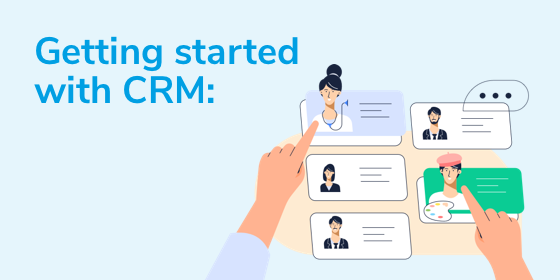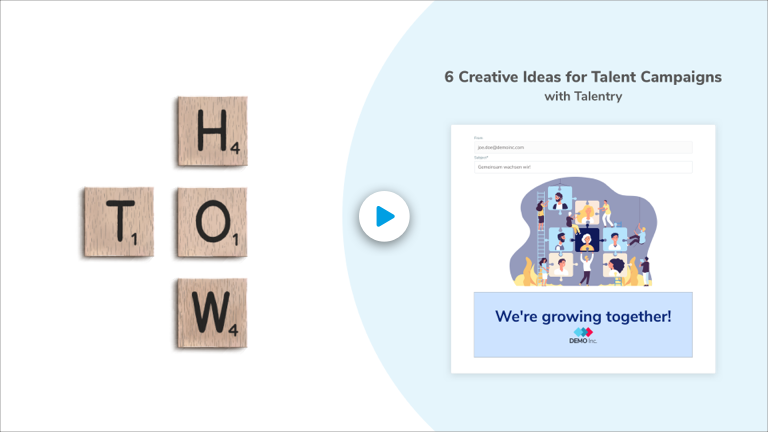Best Practice Interview R+V: Targeted campaigns and new sourcing opportunities with CRM

Contents
1. Why Candidate Relationship Management?
2. What was your first project? And why Talentry?
3. What content do you use for your target-group specific newsletters?
4. What is your approach to segmentation?
5. How do you build your mailing list and enhance older profiles?
6. What differences do you see compared with non-targeted newsletters?
7. What effects do you see for your recruitment KPIs?
10. What do you appreciate about Talentry?
11. What tips do you have for TA teams looking into targeted campaigns?
In conversation with Katharina Zehner from R+V Insurance

You decided to incorporate candidate relationship management in your strategy for recruitment marketing. What was the main reason for this decision?
The recruitment market is changing and demands a more proactive approach. That’s why we have been working on the issue of talent relationship management since 2019. We have always been present at a lot of job fairs, active at universities and colleges and have a lot of visitors to our career pages. This made us ask: Following the initial contact, how can we develop a relationship with these potential applicants? We have also seen a growing need among candidates for more communication and information.
What was your first project? And why did you choose Talentry?
We started with a classic career newsletter. But it quickly became clear that we needed a tool that allowed us to address specific target audiences. This is the only way to avoid, for example, a school pupil receiving the same information as a professional. With Talentry, we can set up different talent pools, thus creating the basis for individual communication. At the same time, the development of talent pools offers new talent sourcing opportunities for our recruiters. In contrast to classic cold calling, our colleagues can approach potential candidates who have already expressed an interest in R+V as an employer. Candidates who then enter the application process already have an insight behind the scenes due to our preparatory work. This ultimately increases the suitability of candidates.
For us, talent relationship management is valuable in two ways: In HR marketing, it allows us to develop relationships by approaching specific target audiences with relevant content. In recruitment, we benefit from a warm talent pipeline for greater efficiency in talent sourcing.
So addressing specific target audiences using special newsletters is a central part of your CRM strategy. What content do you use for these newsletters and how do you generate it?
In HR marketing, we have recognised the importance of content for some time. We have a career advice section, a blog, and are active on social media with stories and other posts - even on TikTok. But we also draw on material from our corporate communications team, provided it could be of interest to potential new employees. That’s why we are in the comfortable position of not having to create new content for each talent campaign. As a rule, we use a mixture of existing content and new stories. We combine them with information about current events or job vacancies, particularly those which may be difficult to fill. This way, we build a bridge to direct recruitment.
Our target audience-specific newsletters show R+V as an employer. At the moment, we have some content about the new world of work. We provide insights behind the scenes using various different formats. Because applicants want first-hand information, i.e. from developer to developer, for example: what does a typical working day look like? How is the teamwork? What systems can I expect? These authentic stories enable communication between equals without the glossy effect of employer branding. We also introduce our recruiters and provide tips for interviews or assessment centre visits.
How do you motivate your employees to take part in “a glimpse behind the scenes” formats?
There were actually some misgivings in the beginning: will my picture appear in all social media channels? Is this necessary? This has changed dramatically in the last two to three years. And, in the course of time, our employees have also realised that these formats are essential for successful recruitment. And that they themselves ultimately benefit if new colleagues can be quickly found.
The basis for talent campaigns that address specific target audiences is segmentation. How do you go about it?
We have designed our registration forms for Talentry so that we can segment our talent community on the basis of the information provided at registration. But to keep the registration process simple, we limit ourselves to two key bits of information: career level and area of interest. This way, we ensure that we don’t send a school pupil the same information as a professional. We can also offer news from appropriate specialist areas. Based on this information, we generate talent pools automatically via Talentry, i.e. a school student who is interested in mathematics will be allocated to both the “school pupil“ and “mathematics” pools. I’ll give you a specific example: we organise an annual “Mathematics Day”. The target market for this are job starters wishing to apply to us as actuaries or mathematicians. For the invitation campaign, I then go to my mathematics pool and filter for students or graduates. Using the two pieces of additional information “career level” and “field of interest”, we are able to make an accurate selection without scaring off talent leads with long forms during registration.
Segmentation with Talentry is extremely easy in practice, but nevertheless very effective. We provide suitable talent leads with the right information, thus creating real added value for our candidates and the employer brand in equal measure.
How do you expand your mailing list and how do you enhance older profiles to improve communication?
For the development of our talent pools, we use all of the instruments available to us in HR marketing: we offer our talent community the opportunity to register on social media or business networks, on target audience-specific landing pages as part of large campaigns, on our career pages; in numerous online profiles for younger target markets such as school pupils and students, as well as at fairs and events, both online and at universities.
We have also incorporated registration links into our correspondence. We use the rejection emails sent to applicants who have passed a particular hurdle, such as a telephone interview, to fill our talent pools with prequalified candidates for future vacancies. With these measures, our pools continually grow.
More is possible of course. That’s why, in the coming year, we want to define a growth rate as a KPI and challenge ourselves a little. Naturally, we have imported our old newsletter recipients into the Talentry community. In order to successively achieve better segmentation as a basis for addressing specific target audiences, we regularly call for the completion of the talent profile in the general newsletters. Even if not all recipients comply with this request, this still contributes to better data quality and thus to the growth of our specialised pools.
What effects do you see compared with newsletter campaigns not aimed at specific target audiences?
The differences are astonishing. We used to have open rates of 20 and, for particularly good newsletters, 30 percent. The click-through rates were five to ten percent maximum. The ‘unsubscribe’ rates were also accordingly high. The Talentry Dashboard shows us at a glance that our target audience-specific talent relationship management is working.
The unsubscribe rate is now below two percent, the open rate is up to 86 percent and click-through rates of up to 66 percent are also more than satisfactory.
We started creating target audience-specific content early on and this has paid off. And with Talentry, we now have the correct solution for delivering this high-quality content to the right talent leads.
Aside from newsletter KPIs, what effects do you notice on recruitment and can they be measured?
We have also defined specific recruitment KPIs. One of them is the turning registered talent leads into applicants. The next step is logically turning them into employees. We’ve been able to record initial successes here too. Integrating Talentry with our applicant tracking system will certainly give us greater insights and is one of the next steps we have on our agenda.
A good catchword! What are the next milestones that you wish to reach with Talentry?
We are working on linking our ATS combined with the ability to upload a CV when registering. This allows our recruiters to better evaluate talent leads.
We already use the automated function from Talentry to inform recruiters about new talent leads in their particular areas of responsibility. Thanks to faster reaction times, we have already been able to make first appointments with a time to hire of just six weeks – and in respect of jobs that are difficult to fill, for which we often had to rely on headhunters for in the past. This is also a great success story internally.
The upcoming integration with our applicant tracking system will make talent sourcing with Talentry easier for our recruiters as well. The integration will also create greater transparency and traceability in our measurement of success. And, ultimately, the good dovetailing of HR marketing and recruitment creates the basis for a good candidate experience and optimises processes likewise. In the first step, we have concentrated on the candidate experience – because, after all, this is what it is about first and foremost. After connecting the ATS, we wish to deal with the processes and, for example, define benchmarks for reaction times. Another issue are new measures for generating talent profiles.
One tiresome but important topic for marketing: GDPR. What has been your experience in this respect with Talentry?
We looked at various providers in the search for a platform for talent relationship management. One of the reasons we decided on Talentry were the high standards of data protection conformity and IT security. As a large insurer and employer, we have very high standards and, with Talentry, we didn’t have to make any compromises or even any modifications. Talentry supports us not least with automation - so that we can operate in compliance with GDPR without having to give it much thought.
A personal question: What do you particularly appreciate about Talentry?
Talentry’s interface capability was a decisive factor for us. In addition, I realised how intuitive Talentry is to use during the very first product presentation. This was also confirmed after implementation. After only 90 minutes of training, our recruiters were ready to go. What I particularly value is the flexibility and customer orientation of the Talentry Customer Success Team, which is always looking for a solution – even for very specific use cases. In general, Talentry is open to customer feedback and further develops its platform based on this feedback. Another plus point is that Talentry’s wide range of solutions, gives us the option, for example, of adding an employee referral programme to CRM system at a later date, without having to look for a new provider.
What tips do you have for talent acquisition teams that are thinking about addressing specific candidate target audiences in campaigns or with newsletters?
Actually, I would like to say just make a start – simply give it a try! But it’s not quite so easy. Content must already be there and is the basis for successful target audience-specific campaigns. I would even take a step back and say know your target audience. You can determine this through appropriate target market analysis, often offered by agencies. You can also do this in a less complicated way. We solved it in part through internal workshops. For this, we questioned employees who have been in the company for no longer than six months about what attracted them at the time. What information did they use to make their decision? What ultimately motivated them to start at R+V? These findings are the basis for creating good content and attracting the right talent with the right message. And then it’s a matter of deciding where the main problem areas are in agreement with the recruitment team. This is then the right target audience for simply getting started.








